Centauri Dreams
Imagining and Planning Interstellar Exploration
Pluto Maps Inspire Thoughts of Bradbury
Something happens when we start making maps of hitherto unknown terrain. A sense of familiarity begins to settle in, a pre- and post-visit linearity, even when the landscape is billions of miles away. To put a name on a place and put that name on a map is a focusing that turns a bleary imagined place into a surface of mountains and valleys, a place that from now on will carry a human perspective. It can’t be undone; a kind of wave function has already collapsed.
And what place more remote than Pluto? At the dwarf planet’s Tenzing Montes, we find striking peaks, some of them running up to 6 kilometers in height, and all this on a world that, until 2015, we weren’t sure even had mountains. Certainly we weren’t expecting mountains this tall, or a terrain this rugged. Given how many years may pass before we have another chance to visit Pluto/Charon, these first official validated topographic maps of the dwarf planet and its moon, just released, will carry our science — and our imaginations — for a long time to come.
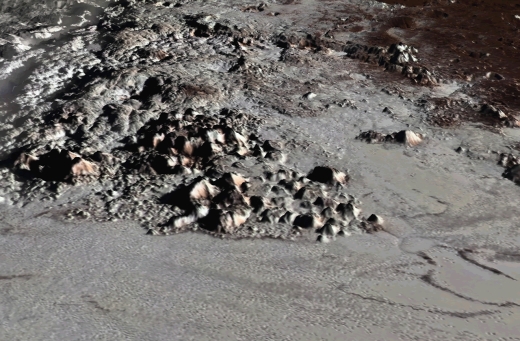
Image: Perspective view of Pluto’s highest mountains, Tenzing Montes, along the western margins of Sputnik Planitia, which rise 3-6 kilometers above the smooth nitrogen-ice plains in the foreground. The mounded area behind the mountains at upper left is the Wright Mons edifice interpreted to be a volcanic feature composed of ices. Area shown is approximately 500 kilometers across. Image credit: Lunar and Planetary Institute/Paul Schenk.
The maps are the work of New Horizons researchers led by Paul Schenk (Lunar and Planetary Institute). The team examined all the images from New Horizons’ Long Range Reconnaissance Imager (LORRI) and Multispectral Visible Imaging Camera (MVIC) systems as the raw material for their mosaics. They aligned surface images where they overlapped and performed digital analysis of stereo images both cameras acquired, producing topographic maps for each region, then assembling these into integrated topographical charts for both Pluto and Charon.
Pluto’s mountains are likely made of water ice, because ices from volatiles like methane and nitrogen would not be strong enough to support such tall features, and as the images show, the steep peaks along the southwestern edge of Sputnik Planitia, itself a frozen sheet of nitrogen, have slopes pushing 40° or more. The topographical maps put large-scale features into perspective and help us see both Pluto’s and Charon’s surfaces in a broader context.
Sputnik Planitia is a good example. Fully 1000 kilometers wide, it contains an ice sheet that averages 2.5 kilometers below Pluto’s mean elevation, which corresponds to sea level on our own planet. The maps also show us that the outer edges of the sheet are an even deeper 3.5 kilometers below mean elevation. These are the lowest known areas on Pluto, a fact that emerges only through study of the stereo images and subsequent elevation maps they spawned. The deep ridge-and-trough system running north to south near the western edge of Sputnik Planitia is more than 3000 kilometers long, evidence for extensive fracturing, as this LPI news release explains. It is the longest known feature on the dwarf planet.
And then there’s Charon. Who would have dreamed in 1978, when astronomer James Christy discovered it, that we would ever have the kind of detail that shows below?
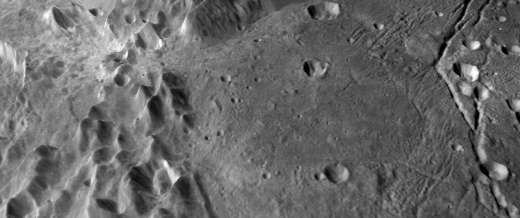
Image: Perspective view of mountain ridges and volcanic plains on Pluto’s large moon Charon. The ridges reach heights of 4 to 5 kilometers above the local surface and are formed when the icy outer crust of Charon fractured into large blocks. The smoother plains to the right are resurfaced by icy flows, possibly composed of ammonia-hydrate lavas that were extruded onto the surface when the older block sank into the interior. Area shown is approximately 250 kilometers across. Image credit: Lunar and Planetary Institute/Paul Schenk.
Maps and Sea Change
In my first paragraph today, I summoned quantum mechanics for inspiration, saying that producing maps created the collapse of a kind of psychological wave function. Adam Alter made the same point a few years back in an article in The New Yorker, where he talked about our association of linguistic labels with the things they denote. The effects can be subtle. Northerly movement, for example, is associated in psychological testing with going uphill, apparently a remnant of the decision of ancient Greek mapmakers to put the northern hemisphere above the southern one.
Alter goes on to speak of what he calls a ‘linguistic Heisenberg principle,” meaning that as soon as you label a concept, you change how people perceive it, and I would assume this goes for landscapes as well. So we’d better choose the place names we put on our maps with care, given the freight they carry in our imaginations. Ray Bradbury knew this as well. His ‘The Naming of Names’ takes Earth colonists on Mars to strange places indeed as they begin to name the places they see.
For in the world of The Martian Chronicles, Mars is a place with a long, long history, and pretty soon the new place names the colonists have chosen begin to morph back into their ancient forms, as spoken by the original inhabitants of the planet. Before long not just the names but the people themselves are changing, returning to existences ancient, rich and strange:
The nights were full of wind that blew down the empty moonlit sea-meadows past the little white chess cities lying for their twelve-thousandth year in the shallows. In the Earthmen’s settlement, the Bittering house shook with a feeling of change.
Lying abed, Mr.Bittering felt his bones shifted, shaped, melted like gold. His wife, lying beside him, was dark from many sunny afternoons. Dark she was, and golden, burnt almost black by the sun, sleeping, and the children metallic in their beds, and the wind roaring forlorn and changing through the old peach trees, violet grass, shaking out green rose petals.
It’s a great tale, and one worth re-reading any time mapping new landscapes comes to mind.
The papers are Schenk et al., “Basins, fractures and volcanoes: Global cartography and topography of Pluto from New Horizons,” Icarus Vol. 314 (1 November 2018). abstract; and Schenk et al., “Breaking up is hard to do: Global cartography and topography of Pluto’s mid-sized icy Moon Charon from New Horizons,” Icarus Vol. 315 (15 November 2018). Abstract. Adam Alter’s “The Power of Names” appeared in The New Yorker‘s May 29, 2013 issue.

TVIW Symposium on The Power of Synergy
Ever since I started Centauri Dreams in 2004, I’ve been talking about the question of infrastructure within the Solar System. My thinking has always been that while we will doubtless get off interstellar missions beginning with robotics on an ad hoc basis during this century, the prospect of a sustained effort will require a built-out infrastructure that will help us create and test out deep space systems of many kinds, from new propulsion technologies to closed loop life support experiments. One step at a time, but do this right and we may push deep into the Kuiper Belt, then the Oort Cloud and, we can hope, beyond.
That’s a long-term vision and it clashes with what we’ve seen since Apollo, a retreat from lunar exploration by humans that may eventually be reversed as we think about partnerships between commercial aerospace and government space programs. To explore these concepts, an upcoming meeting called the TVIW Symposium on The Power of Synergy is to be held in Oak Ridge, TN from October 23-25, 2018. Participants from NASA, DOE ARPA-E, Oak Ridge National Laboratory, the Y-12 National Security Complex, and several private companies are being tasked with the challenge of evaluating where we stand in just such an infrastructure.
TVIW stands for the Tennessee Valley Interstellar Workshop, which has held symposia for a number of years in Oak Ridge, Huntsville and Chattanooga — I’ve been pleased to attend most of these, and you can find my reports from past meetings in the archives here. The upcoming meeting is a departure, a gathering convened to explore a set of specific technologies in the context of the resources and technologies being readied in these high-tech areas.
Synergy — that unpredictable, frequently rewarding process of getting more out of a partnership than the apparent sum of its parts — is to be the theme throughout. Focusing on how the work of government laboratories can mesh with private industry, the symposium is to look at a set of seven key technologies, the thinking being that many of these are reaching the stage where they can create transformative progress in space within a decade. That’s a bracing thought, but the organizers believe that multi-agency cooperation can accelerate space exploration.
Participants in the symposium will be examining, for example, high-impulse nuclear propulsion, as studied in DARPA’s Timberwind Program. Political issues always swarm around nuclear ideas, but high-performance technologies realized through upper-stage nuclear rockets fired only once they have reached Earth orbit or beyond could allow faster transit times, enough so to make human expeditions to Mars far more practical than currently envisioned. Going nuclear has ramifications as well in space solar power and cislunar operations including manufacturing.
Have a look at the symposium website for more on the ideas to be discussed, which include high-energy lasers of the sort now being considered by Breakthrough Starshot as a way to propel small sailcraft with miniaturized payloads to the Alpha Centauri triple system. Closer to home, power beaming in space can help to build a transportation network in the inner system and incentivize exploratory missions to the outer planets. Likewise transformative are high-temperature superconductors, developed for several decades at Oak Ridge National Laboratory. Magnetically inflated cable (MIC) technologies can help in the construction of large space structures. Large-scale 3D printing, another ORNL specialty, points toward manufacturing capabilities in space that would be a necessary part of a permanent human presence.
Rounding out the list of enabling technologies are self-replicating von Neumann machines, solar power satellites and lightweight large-aperture optics. Can we reach the point where small machines can build larger ones out of abundant space resources found, for example, in nearby asteroids? For that matter, can we consider asteroids themselves, suitably modified by such means, as habitats safe from dangerous radiation from cosmic rays or solar storms?
And on the astronomical front, large-aperture optics offers the prospect of space telescopes that dwarf the scale of today’s efforts, including interferometer arrays for the imaging of exoplanets and advances in our knowledge of cosmology. What the symposium organizers are arguing is that all of these technologies are developing at a pace sufficient to think realistically about fleshing out a near-Earth infrastructure that can swiftly be extended to Mars and beyond.
The speaker list is being fleshed out now, but among those scheduled so far are Michael Raftery (Boeing and Explore Mars, Inc) on the ‘NASA Lunar Gateway Concept;’ Franklin Chang-Diaz (Ad Astra Rocket Company) on ‘Living and Working in Space;’ Phil Lubin (UCSB) on ‘Directed Energy Propulsion – Interplanetary and Interstellar;’ John Mankins (Artemis Innovation Management Solutions) on ‘Space Solar Power Stations;’ Bill Peter (ORNL) on ‘Large 3D Printing;’ Robert Bagdigian (NASA MSFC) on ‘Environmental Control & Life Support;’ and Joel Sercel (Trans Astronautica Corporation) on ‘Capture & Uses of 10 Meter Asteroids.’
The venue in Oak Ridge will be the Y-12 New Hope Visitor Center. Those interested in attending can visit the TVIW Symposium on the Power of Synergy website for more information.

Listening in on Enceladus
When I was a boy, I used to scan shortwave frequencies with an old Lafayette receiver in search of distant stations. When I learned that Jupiter was a radio source, my passion for radio DXing took a new turn, merging with my interest in astronomy. When I tried to log the planet’s violent outbursts, I learned with a little digging in the library that Jupiter could be detected from about 15 MHz up to 40 MHz, with the best window somewhere between 18 MHz and 28 MHz.
Called ‘decametric noise storms,’ the Jovian bursts sometimes sounded like ocean waves hitting a shore, but there were also short bursts that could be confused with local lightning, and to this day I’m not really sure whether I really heard Jupiter or not. When you’re listening for something that sounds like the ocean in the shortwave bands, it’s all too easy to think you’re hearing it in the background noise, and a little imagination makes you think you’ve found your target.
These days we can listen to just about anything on the Internet, so I’ll point you to the Io B storm of November 27, 2001, on a page that offers charts, links and an anecdotal account of a reception. Jupiter seems to have acquired a fan base among amateur radio astronomers.
But enough of Jupiter. This morning we need to talk about Saturn and the plasma waves Cassini detected moving from the planet to its rings and the moon Enceladus. These produce the distinctive sound you can hear in the YouTube video below. (If you get Centauri Dreams through email, the video isn’t going to show, but go to this link to see it). Here the recording time was compressed from 16 minutes to 28.5 seconds.
Image: New research from the up-close Grand Finale orbits of NASA’s Cassini mission shows a surprisingly powerful interaction of plasma waves moving from Saturn to its moon Enceladus. Researchers converted the recording of plasma waves into a “whooshing” audio file that we can hear — in the same way a radio translates electromagnetic waves into music. Much like air or water, plasma (the fourth state of matter) generates waves to carry energy. The recording was captured by the Radio Plasma Wave Science (RPWS) instrument Sept. 2, 2017, two weeks before Cassini was deliberately plunged into the atmosphere of Saturn. Credit: NASA/JPL-Caltech/University of Iowa.
The plasma wave interactions are the subject of a recent paper from lead author Ali Sulaiman (University of Iowa), who is a member of the Radio Plasma Wave Science team, RPWS being the instrument on Cassini that recorded these waves traveling on magnetic field lines.
“Enceladus is this little generator going around Saturn, and we know it is a continuous source of energy,” says Sulaiman. “Now we find that Saturn responds by launching signals in the form of plasma waves, through the circuit of magnetic field lines connecting it to Enceladus hundreds of thousands of miles away.”
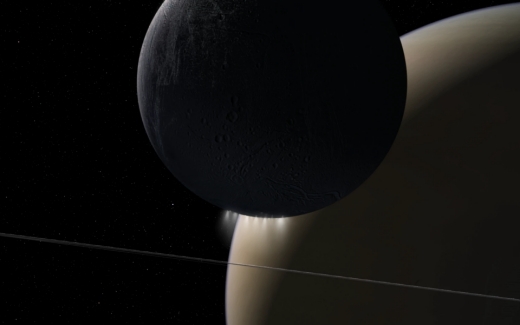
Image: NASA’s Cassini spacecraft’s Grand Finale orbits found a powerful interaction of plasma waves moving from Saturn to its rings and its moon Enceladus. Credit: NASA/JPL-Caltech.
Enveloped by Saturn’s magnetic field, Enceladus is a geologically active place, emitting the famous geysers we’ve so often examined in Cassini imagery. The plumes of water vapor from what appears to be an inner ocean become ionized, accounting for the strong interaction between Enceladus and the planet; similar interactions occur between Saturn and its rings.
We get this information thanks to Cassini’s high-inclination Grand Finale orbits, which brought the spacecraft both to its closest approach to the cloud tops and to the inner edge of the D ring. The recording itself was captured on September 2, 2017, just two weeks before Cassini’s final plunge. Measurements of the top of the ionosphere as well as the environment around the rings showed the plasma wave interactions and underline the dynamic nature of the Saturn system.
The paper is Sulaiman et al., “Enceladus auroral hiss emissions during Cassini’s Grand Finale,” published online by Geophysical Research Letters 7 June 2018 (abstract).

The Apkallu Initiative: A Minilithic Artefact for Rebooting Human Civilization in the Event of Global Cataclysm
Kelvin Long is a familiar face on Centauri Dreams, the author of several previous articles here and many publications in the field of interstellar studies. The creator of Project Icarus, the re-design of the Project Daedalus starship of the 1970s, Long was a co-founder of Icarus Interstellar and went on to head the Initiative for Interstellar Studies. He also served as editor of the Journal of the British Interplanetary Society during a critical period in the journal’s history, and authored Deep Space Propulsion: A Roadmap to Interstellar Flight (Springer, 2011). Today he turns his thoughts to catastrophe, and the question of what would happen to human civilization if it were reduced to a small remnant. Could we preserve the most significant treasures of our science, our culture, in the face of a devastated Earth? Exploring these ideas takes us deep into the past before turning toward what Kelvin sees as a possible solution.
by Kelvin F Long
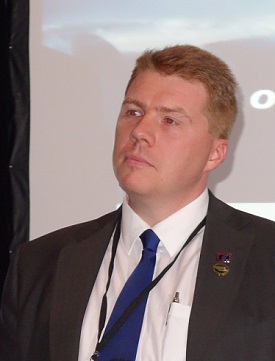
The year is 2050. Earth is a thriving metropolis with a population exceeding 9 billion. Progress has been made in harmonising social-cultural tensions around the world and nation state war is now an infrequent event. A young child of the future steps out into the bright sunshine of a gorgeous new morning. Her day is still ahead of her as she out stretches her arms and smiles at the mellifluous call of the singing birds. But then looking up, she notices something in the distance, a long streak across the sky that is moving rapidly, and seems to be descending towards the ground. It disappears behind the horizon, and shortly later a blinding flash engulfs the world. The girl looks on stunned, eyes struggling against the light, to see the gradual build-up of a mushroom cloud that starts to reach high into the atmosphere. The impact event was hundreds of miles away, yet soon it engulfs the world in a global climate change and sends Tsunamis sweeping over coastal cities destroying all in the path. In response to oceanic earthquakes, the water becomes so big, that it pushes across the flat land masses; unrelenting mega white horses to a trampled poppy field below. One day, this will form into wedge shaped chevron deposits hundreds of feet high, composed of ocean floor micro-fossils. Within days of the event the girl will learn that billions of people are wiped out as the human civilization draws to a rapid stagnation. All infrastructure and governments are gone, and only small pockets of communities around the world survive, numbering thousands at best. She was one of the lucky ones, her small community of one hundred people survived just barely on their high mountain top position. This is fortunate for a girl named Hope.
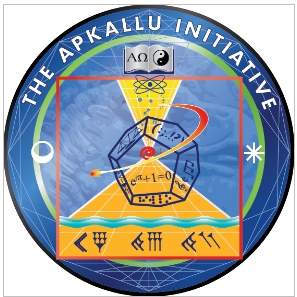
Introduction
The future is uncertain. Whilst it is important to emphasise the positive reasons for the exploration of Earth and space, it is also important not to be in denial about the risks that really face us; for they are not insignificant. They are many and varied in type. From the potential for nation state warfare, to disease pandemics, to global climate change, to risks from above such as impact events by asteroids or comets or even the possibility alien invasion. The sure way to guarantee our survival is to follow the lead of Elon Musk and to make the human race an interplanetary species; and indeed to go further with an interstellar species. But until we have reached this point we are vulnerable. The proposal made in his article is not an alternative to the current plans for the colonization of space and the continued building up of infrastructure, but it is a complimentary pathway to increase the probability of human survival into the coming centuries. In particular, it should be taken on board that the assumptions of this project is that a possible future exists where rocket technology no longer even exists as a worst case survival scenario.
The Apkallu initiative is a proposed project to help reboot human civilization, on the assumption that some small pockets of human communities survive around the world during a global cataclysm, but all the remnants of our industrialised and developed civilization are destroyed. This includes our cities, our farms, our libraries, our infrastructure, and our transport networks; in essence the human race is thrown back to being a hunter-gatherer species and must begin again. It is named after the Sumerian sages who are said to have helped humankind establish civilization and culture and giving us the gifts of a moral code, mathematics, architecture, agriculture and all ways necessary to teach us how to become civilized. The Sumerian civilization is one of the first to appear in recorded history, which included the invention of its own writing form called Cuneiform. Before we discuss what the Apkallu initiative actually is, it is worth reminding ourselves of some essential context.
Impact Threats and Other Risks to Human Survival
We know that objects have impacted the Earth throughout its history and continue to do so today. Approximately 66 million years ago, it is believed that an impact event resulted in the Cretaceous-Tertiary (K-T) extinction. This led to devastation in the global environment and a prolonged winter which affected the photosynthesis of plants and plankton life. It also resulted in the destruction of a plethora of terrestrial organisms, including mammals, birds, insects and most famously the dinosaurs. The object, an asteroid or comet, was 10-15 km in diameter with a likely impact velocity of around 20 km/s and an associated kinetic energy of impact of around 30,000 – 1000,000 Gtons TNT equivalent, depending on the assumptions. It left an impact crater in the Yucatan Peninsula in Mexico, and likely created 300 feet high Tsunami’s over an impact zone of around 3,000 miles.
Another example is the Arizona Meteor crater, which was the result of a Nickel-Iron object around 50 m in size impacting the Earth 50,000 years ago. With impact velocities ranging from 2.8 – 20 km/s this would have impacted with an associated kinetic energy of 10.7 – 26.2 Mtons TNT equivalent. Today, a crater remains of the impact event, 1.2 km in diameter and over 550 feet deep.
In 1908 a comet is believed to have impacted eastern Siberia, causing a flattening of a forest 2,000 square km in size. Since no impact crater was found, it is believed that the object disintegrated at an altitude of 5 – 10 km above the ground. The estimated energy of the air burst explosion was 10 – 15 Mtons TNT equivalent; depending on the assumptions one makes.
In July 1994 a comet split into 21 fragments ranging in size up to 2 km, and impacted the upper atmosphere of Jupiter with an impact velocity of around 60 km/s. The total energy of these impacts was around 6,000 Gtons TNT equivalent creating dark red spots with some being 12,000 km in size. Had this comet impacted the Earth, it would have posed a major threat to human existence.
During late 2017 we observed the close flyby pass of an asteroid of interstellar origins named ‘Oumuamua. Much of the nature of this objects remains uncharacterised, but some sensible estimates of the maximum potential impact energy suggest 4.2 – 46.9 Gtons TNT equivalent, had it impacted the Earth.
Then in April this year that an object named Asteroid 2018 GE3 passed closed to Earth and was spotted 119,500 miles away, which is closer than the Moon, which orbits at an average distance of 238,900 miles. The object was first observed by the NASA funded Catalina Sky Survey project based at the University of Arizona Lunar and Planetary Laboratory. It was first observed a mere 21 hours before the closest approach to the Earth. The object was estimated to be at least 150 – 360 ft in diameter.
How many more are out there waiting for us? No doubt some will argue that the impact risks are statistically small and we should not be concerned about them. We know there are many asteroids in our own Solar System, varying in size from 1 m up to 1,000 km. Approximately 16,000 objects have been found near Earth, but this is a small fraction of the estimated total that is out there, which varies between 1 – 2 million. Statistically, this presents a threat to human existence and life as we know it. Indeed, it is the belief of this author that impact events which can lead to global devastation of the human population may be as frequent as 1/1,000 – 1/10,000 years.
In addition to impact risks there are many other threats to human existence. This may include the implications of magnetic field reversal. Such an event occurred 41,400 years ago during the last ice age, called the Laschamp event. It caused a magnetic field reversal leading to a drop in its strength. This resulted in more cosmic rays reaching the Earth and an increased production of the isotopes Beryllium 10 and Carbon 14.
There are also the risk of enhanced solar activity such as through large scale solar flares, or the possibility of the Sun entering unstable periods in its evolution for which are current models of stellar-structure are not aware. This could be due to the passage of our Sun through the spiral density arms of the galaxy. There are the risks of nation state war or even global thermonuclear war that could drive us towards extinction, either through direct destruction or through altering the climate. There are the risks of human disease pandemic, which surely must become more probable in an increasing global population. There are the risks of human destruction of elements of the biosphere, such as pollutions of the oceans, soils, deforestation or polluting of the atmosphere. There are the risks that microbes could be introduced into our biosphere from an alien planet that is infectious to our biodiversity.
Then there is the actual risk of alien invasion, from a species set on conquering other lower species or seeking resource acquisition no matter the costs. It may be assessed that some of these are low probability. However, the fact that there are so many risks to the future survival of humankind should be a concern, and it is vital that we take a proactive approach to adaptability and survival, instead of a reactive one when such events occur.
Assumptions of a hypothetical Near-Human Extinction
Imagine a situation where human kind is nearly wiped out by some global cataclysm. This could be an impact event or one of the other risks highlighted earlier. In a worst case scenario, but one where some humans survive, we might make the following assumptions:
- 1. All infrastructure is destroyed, to include buildings, power utilities, city plumbing, dams, transport networks, agriculture and farming, huge portions of the plant and animal kingdom.
- 2. All information sources are destroyed, to include all the world libraries, computers and electronic memory. It is possible that some books will be discovered over time as communities explore the rubble remaining from the metropolis. Books would become precious beyond their current value.
- 3. The global climate is in turmoil and hostile, but with isolated regions of stability such that with determination survival is possible.
- 4. The geological, climatic, oceanic activity and effects of the cataclysm event, within weeks, months or years will gradually return towards some level of stable Earth.
- 5. Small pockets of humans survive around the Earth, perhaps 10s to 100s each but with the total not exceeding thousands.
Given this scenario, we can note that the surviving generation will remember the world as it was before. They will use this knowledge to teach their children. At this point knowledge is based upon direct memory. Those children will then grow up, with their parents dying off, and they will remember what their parents taught them and some of those children may even have some memories of the world before. But for the most part we are dealing here with recent history and part mythology. The grandchildren will also be born and grow up, but they will have no direct memory of the world the way it was before. At this point we are dealing with history and mythology. Within the third or fourth generation there is a risk that all knowledge will be lost, and especially if that knowledge is not captured and written down. All received knowledge then becomes both mythology and fantasy.
There are solutions to this practiced by the Native North Americans for example, which is to communicate stories verbally and also use this to impart wisdom, and those stories are accompanied by rituals. However, one cannot believe that such a method of communication does not contain significant information error propagation with each successive generation, compared to the original version.
The History of Humans on Planet Earth
In the event of a global cataclysm, assuming small pockets of human communities survive, but the majority of human civilization and associated technological infrastructure is destroyed, how can we ensure a chance at rebooting human knowledge? Indeed, is it possible that this has in fact occurred in the recent past and this is a part reason for the many Megalithic structures on Earth?
Until recently, Sumer was the earliest known civilization in the historical Mesopotamia, and is located in modern Iraq. It dates back to 3,000 B.C and was likely settled around 4,000-5,500 B.C by proto-Euphrateans or Ubaidians. The people from this era are credited for many great inventions and discoveries which led to the advance of their society. This includes in mathematics, geometry, agriculture, architecture, economics and law to name a few. One of the most famous objects discovered from this period is the Code of Hammurabi, a 2.25 m tall stone wall consisting of 282 laws, such as “an eye for an eye” and is the first legal system from the Old Babylonian period.

The Code of Hammurabi, created 1750 B.C, currently housed at the Louvre, Paris (image credit: K. F. Long)
It is important to note that in the Babylonian creation mythologies, which were written in Cuneiform, there are around a thousand lines of text on seven clay tables. The focus of this text is the creation of humankind for the service of the gods. These texts are called the Enûma Eliš, and arguably they have a clear lineage to the Judeo-Christian Bible. The Cuneiform script was scribed, using a wedge-shaped marker onto a wet clay tablet and also cylinder seals. These are small round objects typically an inch in length engraved with information. Once dried the inscription was permanent. The information preserved on tablets and seals was Cuneiform text but also contained figurative scenes or descriptions of events or objects. Such objects are breathtaking in their clarity, gorgeous in their artistic nature, and contain a wealth of information about the society, its rituals, values, business, science and technology.

Photographs of Sumerian Cylinder Seals from the Private Collection of the Author (image credit: K. F. Long)
The Holy Bible records a flood story that engulfed all of planet Earth. This is recorded in Genesis chapters 6 – 9, and the flood seems to last for around one hundred and fifty days. Other cultures have recorded similar stories. For example the Sumerian tale of Ziusudra and the Atra-Hasis also describes a global flood story that is similar to that told in Genesis. In the Sumerian story the flood lasts for seven days. An account is also told in the Epic of Gilgamesh, which is more similar to the Biblical story. Also, the Hindu mythology tells of a great flood in the Satapatha Brahmana. It is very easy to dismiss the possibility of a global flood as pure mythology, but the occurrence of a similar story in so many cultures around the world is at least suggestive that it may be a memory of an actual event which many today are regarding as mythology. Indeed, science may be catching up with the past.
Geologists and climatologists study a period in Earth’s history called the Younger Dryas, which occurred 12,900 to 11,700 years ago and saw a return to glacial conditions which temporarily reversed the gradual climatic warming after the last glacial maximum which began receding around 20,000 years ago. It led to many catastrophic effects including the decline of the Clovis culture in North America and the extinction of many megafauna which included the Mammoths; the last of which survived into the Holocene around 4,500 years ago in Africa, Europe, Asia and North America.
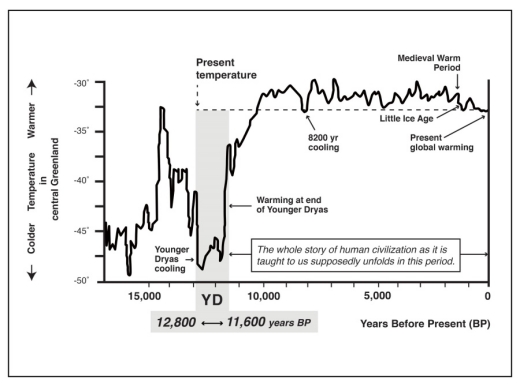
Illustration of the Younger Dryas period
In recent years, evidence is emerging that the Younger Dryas period may have been caused by a cometary impact event on the North American ice sheet, around 12,900 years ago. The evidence for his includes the discovery of a 10 million ton deposit of impact spherules across four continents, and the discovery of a Nano-diamond rich layer. In addition, analysis of underground soils indicates massive wildfire and abrupt ecosystem disruption on California’s Northern Channel Islands. Scientists have also discovered very high temperature impact melt products as evidence for an air burst explosion. All of this is dated to around 12,900 years ago, at the onset of the Younger Dryas. If this is proven to be correct, then a global cataclysm may indeed have occurred in our recent past. Speculating, if any advanced civilizations existed on Earth prior to this date, they may have been wiped out by this cataclysm forcing civilization to start from the beginning again.
At some point in our past we moved from a hunter-gatherer species to an agricultural-farming one, where we embraced the domestication of animals and crops. This is marked by a period called the Neolithic, and occurred around 10,200 years ago. It is considered to be the last period of the stone age and commenced the beginning of the Neolithic revolution. It ended with the emergence of the Copper and Bronze and Iron ages and our new abilities to use metals. It is remarkable that we have apparently exploded technologically and social-culturally over the last 10,000 years or so to the state where we have computers, cars, aeroplanes and communication satellites. What was it that propelled us forward over such a short space of time? Why had we not achieved this level of maturity previously? Was it the formation of a critical population density? Was it global climatic conditions? What is our tribal nature and inability to get organized? What it some other threats to our existence?
Homo sapiens in our modern form may be several hundred thousand years old. Paleolithic cave art certainly goes back to 40,000 years but may be 60,000 years if we include what is currently being claimed to be art from Neanderthal man. Evidence from the out of Africa hypothesis puts homo sapiens at around 130,000 – 180,000 years old. But there are alternative versions which claim populations emerging out of Africa as early as 350,000 years ago. Evidence for older findings includes discoveries of anatomically modern human skull fossils at Jebel Irhour in Morocco (315,000 years) and Middle Awash in Ethiopia (160,000 years). The history of human evolution is far from settled and ‘thinking man’ may be much older than we realised.
Ancient Megaliths
A story from ancient Sumeria is that of an amphibious being called Oannes (also known as Adapa) who apparently taught humankind wisdom. The story was told by Berossus in 290B.C, a Chaldean Priest in Babylon. Berossus described Oannes as having the body of a fish but underneath the figure of a man. He is said to dwell in the Persian Gulf, rising out of the waters in day time and furnishing humankind in the instruction of writing, arts and other subjects. Here are the words of Berossus:
“At first they led a somewhat wretched existence and lived without rule after the manner of beasts. But, in the first year appeared an animal endowed with human reason, named Oannes, who rose from out of the Erythian Sea, at the point where it borders Babylonia. He had the whole body of a fish, but above his fish’s head he had another head which was that of a man, and human feet emerged from beneath his fish’s tail. He had a human voice, and an image of him is preserved unto this day. He passed the day in the midst of men without taking food; he taught them the use of letters, sciences and arts of all kinds. He taught them to construct cities, to found temples, to compile laws, and explained to them the principles of geometrical knowledge. He made them distinguish the seeds of the earth, and showed them how to collect the fruits; in short he instructed them in everything which could tend to soften human manners and humanize their laws. From that time nothing material has been added by way of improvement to his instructions. And when the sun set, this being Oannes, retired again into the sea, for he was amphibious. After this there appeared other animals like Oannes.“
Whether this is pure fiction or has any resemblance to historical events does not matter, but it is this story that has given rise to the idea of building what this author is calling a ‘minilithic artefact’ under the Apkallu Initiative as will be discussed further below. As an aside it is worth noting that in his book Intelligent Life in the Universe, written with L. S. Shklovskii (Pan Books, 1977), the astronomer Carl Sagan opened a discussion on the Sumerian civilization with “I came upon a legend which more nearly fulfils some of our criteria for a genuine contact myth”.
On planet Earth we know that species rise up and fall and suffer extinction. The fossil record has shown this for many a species. There are also arguments that Homo Sapiens are not the only occurrence of intelligence on Planet Earth (see for example the recent book Other Minds by Peter Godfrey-Smith’ on the Octopus, William Collins, 2016). Why then is it not possible, in the last million years, that an earlier species of man, or other life form on Earth, could have evolved to similar levels of intelligence to that which we possess today, to include a technological level similar in extent? Such a people would predate modern recorded history, and it is at least plausible that some memory of them could be preserved in the creation mythologies of our various ancient cultures.
Many ancient Megalithic structures have been found by archaeologists around the world. This includes for example the Great Pyramid and the Great Sphinx in Giza (4,500 years old), Tiwanaku and Pumapunku in West Bolivia (3,500 years old), Stonehenge in England (5,000 years old), Machu Picchu in Peru (550 years old) to name a few. However, recently our linear understanding of human evolution from a hunter-gatherer species to an agricultural-farming one has been placed under scrutiny, by the discovery in 1996 of G?bekli Tepe, a site in the South eastern Anatolia region of Turkey, which may date back to 12,000 years old. The site demonstrates a superior knowledge of construction techniques, geometry and other disciplines and to enable its construction would have required a food surplus to exist – before the arrival of the Neolithic revolution. In addition, it is arguable that to get to a point where you can construct something like G?bekli Tepe would take thousands of years of advancement of knowledge in itself. This might suggest that the builders were 15,000 – 20,000 years old.
A potentially even older site has also been found in West Java, called Gunung Padang, which was discovered in 1914. It may be the largest megalithic site in South Eastern Asia. Radiocarbon dating puts the site at several different eras spanning 6,500 – 20,000 years ago, although the dating claims are controversial among archaeologist in Indonesia. A large structure has also been discovered beneath the surface some 15 m down and includes large chambers. This discovery, and that of G?bekli Tepe, is telling us that our linear understanding of history is in need of revision.
Interglacial Periods in Earth’s History
Given the existence of G?bekli Tepe and Gunung Padang, the idea that an earlier intelligent and advanced civilization existing on Earth is not so implausible. However, were there opportunities in Earth’s history for this to occur? An examination of climatic conditions would seem to suggest so.
During the history of Earth there have been five major ice ages, and we are currently in the Quaternary Ice Age at this time, which spans from 2.59 million years ago. Within the ice ages are sub-periods known as glacial and interglacial periods.
Recent measurements of the relative Oxygen isotope ratio in Antarctica and Greenland show the periods of glacial and interglacial periods throughout history over the last few hundred thousand years. This is a measurement of the ratio of the abundance of Oxygen with atomic mass 18 to the abundance of Oxygen with atomic mass 16 present in ice core samples, 18O/16O, where 16O is the most abundant of the naturally occurring isotopes. Ocean water is mostly comprised of H216O, in addition to smaller amounts of HD16O and H218O. The Oxygen isotope ratio is a measure of the degree to which precipitation due to water vapour condensation during warm to cold air transition, removes H218O to leave more H216O rich water vapour. This distillation process leads to any precipitation having a lower 18O/16O ratio during temperature drops. This therefore provides a reliable record of ancient water temperature changes in glacial ice cores, where temperatures much cooler than present corresponds to a period of glaciation and where temperatures much warmer than today represents an interglacial period. The Oxygen isotope ratios are therefore used as a proxy for temperature changes by climate scientists.
The Vienna Standard Mean Ocean Water (SSMOW) has a ratio of 18O/16O = 2005.2×10-6, so any changes in ice core samples will be relative to this number. The quantity that is being measured, ?18O, is a relative ratio calculated as in the units of % parts per thousand or per mil. The change in the oxygen ratio is then attributed to changes in temperature alone, assuming that the effects of salinity and ice volume are negligible. An increase of around 0.22% is then defined to be equivalent to a cooing of 1?C.
There are differences in the value of ? between the different ocean temperatures where any moisture had evaporated at the final place of precipitation. As a result the value has to be calibrated such that there are differences between say Greenland and Antarctica. This does result in some differences in the proxy temperature data based on ice core analysis, and Greenland seems to stand out, such as indicating a more dramatic Younger Dryas period (11,600 – 12,900) than other data.
An analysis of this data shows that the climate has varied cyclically throughout its history and is manifest of natural climate change. In particular what emerges out of the data are some interesting lessons about the recent history of planet Earth. Data shows the rapid oscillations of the climate temperature from the average temperature of today, indicative of glacial and interglacial periods. In particular, the data shows that during the Holocene period, beginning approximately 11,700 years before present, the temperature varied between 2-4 ?C.
It is reasonable to assume that human civilizations under development will do better when the climate is kinder. This means that the warmer it is the better civilisations will do, and the colder it is, the harder the struggles. In particular we can expect that during the conditions of a colder climate that agricultural farming will suffer, and so there will be less food to go around, which will affect both lifespan and population expansion. To support this it is worth noting that the current epoch, the last 10,000 years has been one of the longest interglacial period for at least the last quarter of a million years and it is reasonable to therefore assume that this is one of the factors which has allowed human development from the emergence of the Neolithic period coming out of the last ice age.
The data also shows that there was a large global warming period known as the Eemian around 115,000 – 130,000 years ago. The average global temperatures were around 22 – 24 ?C, compared to today where the average is around 14 ?C. Forests grew as far north as the Arctic circle at 71? latitude and North Cape in Norway Oulu in Finland. For comparison North Cape today is now a tundra, where the physical growth of plants is limited to the low temperatures and small growing seasons. Given that homo sapiens may have been here since around 300,000 years ago, this seems like a major opportunity for the development of human society from a people of hunter gatherers to one of agricultural developers and the development of a civil society.
There have been other interglacial periods that have resulted in global temperatures being either equivalent or above the average today, and the data shows temperature spikes of periods at around 200,000 years, 220,000 years, 240,000 years, 330,000 years and 410,000 years. Each of these interglacial periods will typically last at least 10,000 years.

Temperature Proxy Data Showing Opportunities for the Rise of Advanced Civilization in Recent Prehistory
The Apkallu Initiative
It is fully admitted that much of the above contains speculation, but until we have a firmer grasp of history it would be unwise to rule such possibilities out. We turn our attention then to the future and solving the problem of how to preserve human knowledge in the event of a global cataclysm such that humankind can restart again so that within centuries we mature back to similar levels of today’s technological advancement. Ultimately this is a statistical problem, in that by reducing the time of each cycle for maturing to technological capability, one improves the probability of survival. It is sensible to think of this concept as a civilization accelerator.
The Apkallu Initiative is therefore a proposal to construct a minilithic artefact (analogous to Megalithic artefacts) that can survive for a time duration exceeding 100,000 years. This duration is chosen for three principal reasons:
- 1. The recent ice core records suggest that within that time period there may be several opportunities (~4) where the climatic conditions are sufficiently supportive for human existence to facilitate growth beyond basic survival.
- 2. It approximately corresponds to four processional cycles of the Earth around the equinoxes, which typically last 25,920 years. We note that many of the ancient Megaliths seem to have been preoccupied with the measurement of the equinoxes; which may relate to lost memory of previous cataclysms.
- 3. It is difficult to design for an artefact that can survive longer than this, although desirable.
The artefact would be a form of archaeological-architectural device from the standpoint of future humans who uncover it. The device would be replicated perhaps 1,000 times and distributed around the seven continents of the Earth. Ideally, some could also be placed in space, on the Moon or Mars. The idea is that any future human surviving a global cataclysm that finds this artefact and studies it sufficiently, it will give them the knowledge they need to rapidly advance human civilization at an accelerated rate.

Painting illustrating future man finding the archaeological artefact (credit: K. F. Long)
The artefact would be a form of long distance communication. We have of course attempted message plaques in the past such as the Voyager Golden Record and the Pioneer Plaque. Indeed, the Code of Hammurabi from the Sumerian civilization is a form of minilithic artefact, but just specific to moral and legal codes. Another example would have been the tablets for the Biblical Ten Commandments.
There is a question of what materials to construct the artefact from. Plastics and metals will likely degrade over thousands of years. Electronic memory is not useful if it is subject to flip switching and also requires a computer interface to read it. It therefore seems sensible to construct the artefact out of stone; perhaps in a similar manner to the Sumerian Cuneiform on wet clay tablets. One of the options may be Diorite. It would perhaps be useful to depict both logograms, with syllabic and alphabetic elements, as well as phonetics and even determinatives to create appropriate semantic descriptions.
There is a question of what information should the artefact contain. It should contain the foundation knowledge of human civilization. This is a subjective decision. One example we might take lessons from for example was the Trivium (logic, grammar, rhetoric) and the Quadrivium (arithmetic, geometry, music, astronomy) of the classical world. Both were considered preparation work before delving into the study of philosophy and theology. In addition to these, the artefact might contain many other disciplines of thought, such as human biology, medicine, architecture, chemistry, physics, law, history, music, language, agriculture, botany, ethics and other subjects. Experts in appropriate disciplines would need to be consulted to derive the say 12 base foundation knowledge or tenets that govern a field from which in principle all else can be derived given time.
The goal of the information content imprinted onto the artefact would be as follows:
- Goal 1: The continued survival of the human species at peace.
- Goal 2: The accelerated technological, social-cultural growth of human civilization from an assumed stagnated level.
- Goal 3: The preservation of moral and ethical philosophy
There is also a question of what language. One approach would be to take lessons from historical artefacts which contained several languages to ensure future interpretation. This includes the Rosetta Stone (2,200 years old) which contains ancient Egyptian hieroglyphics, demotic and ancient Greek. Another example is the Fuente Magna of the Americas (5,000 years old), found in Bolivia but contains both ancient Pukara and a proto-Sumerian alphabet. Another example is the Behistun inscription (2,500 years old) found in Iran, which contains three different cuneiform script languages, that of Old Persian, Elamite and Babylonian.
There is also the question of the size and shape of the artefact, and although you want it big enough to find, you also want to manage the construction cost of the project. Something around 6 – 12 inches would seem a good optimum size. The exact shape would have multiple surface areas to facilitate different disciplines of knowledge. One idea is a Dodecahedron, which has 12 faces.
The proposal of the Apkallu Initiative is to form a team which then designs and leads the construction of such an artefact. This can then be reproduced and distributed to different locations around the world. Some would eventually be displayed in art galleries or museums and some will be lost to the land and sea, but the hope is that in the event of the cataclysmic scenario described above that future human will stumble across such an artefact, and after studying it, teach their community everything they need to become a civilized and socially-technologically advanced society. Currently no team has been formed, but this article is an initial invitation of interest and anyone interested can contact the web site: https://www.apkalluinitiative.com/
Our ability to become an interstellar capable species depends in the near term on our ability to survive here on Earth or in near-space. The preservation of the deep knowledge and learning of the human experience is critical to this future, if we are to continue to progress, avoid stagnation and decay or even complete extinction or avoid repeating mistakes of the past.
Finally, such a project has the potential to inspire long-term thinking among differing human societies, and so in itself may be a self-perpetuating mechanism toward social-cultural harmonization and increased global awareness of our fragility in the great Cosmos. In addition, because of its interdisciplinary nature, it has the potential to involve all of humanity on its journey, as we jointly work toward a back-up plan to ensure that humanity can survive in the millennia ahead.
The author dedicates this article to the efforts of Graham Hancock and Randall Carlson, whose significant research inspired this initiative. It was written to garner scrutiny of the idea, before deciding whether to proceed or not. Feedback is invited.

Occator Crater Up Close
It’s startling to think that the Dawn spacecraft, now orbiting Ceres at its lowest altitude ever, may have fired its ion engine for the last time. The event occurred by way of positioning the spacecraft for the best possible track near Cerealia Facula, which is a prominent deposit of sodium carbonate in the center of the crater called Occator. Data from the spacecraft’s visible and infrared imaging spectrometer had been used to identify the bright areas called faculae as calcium carbonate deposits earlier in the mission. Vinalia Faculae is in the same area.
“Acquiring these spectacular pictures has been one of the greatest challenges in Dawn’s extraordinary extraterrestrial expedition, and the results are better than we had ever hoped,” said Dawn’s chief engineer and project manager, Marc Rayman, of NASA’s Jet Propulsion Laboratory, Pasadena, California. “Dawn is like a master artist, adding rich details to the otherworldly beauty in its intimate portrait of Ceres.”
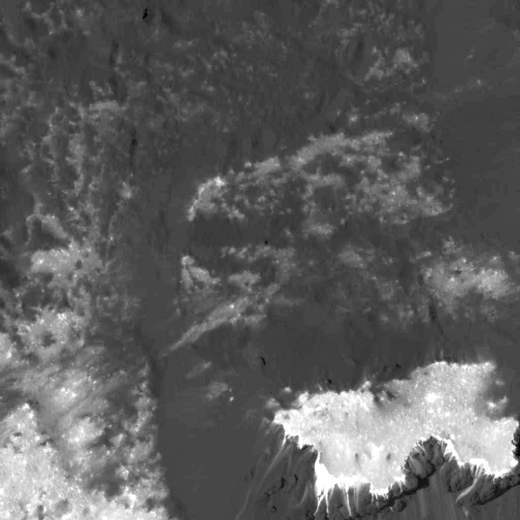
Image: A prominent mound located on the western side of Cerealia Facula, in an image obtained by NASA’s Dawn spacecraft on June 22, 2018 from an altitude of about 34 kilometers. Credit: NASA/JPL-Caltech/UCLA/MPS/DLR/IDA.
You’ll recall the intriguing bright material that began showing up during Dawn’s approach to Ceres, the investigation of which has been a major theme for mission controllers. Imagine if we had a Pluto orbiter to rival what Dawn is doing at Ceres, with the opportunity to map the entire surface, and to delve deeply into the unusual geology on display there. In the case of Ceres, we can now say that the mound above, located at about 19.5 degrees north latitude and 239.2 degrees east longitude, is similar, in JPL’s words, to ‘a mesa or large butte with a flat top.’
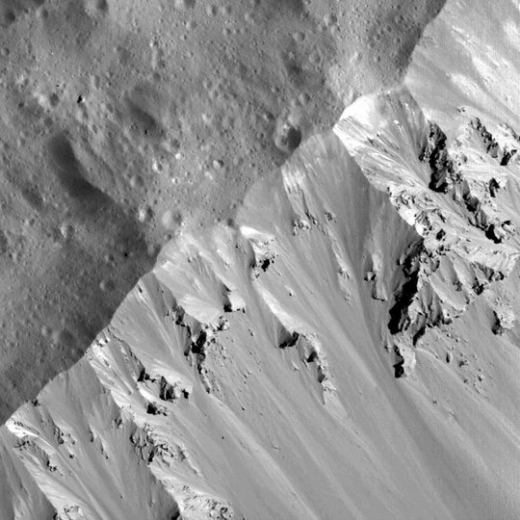
Image: In this image of the northern rim of Occator crater landslides can be seen. The image was obtained by NASA’s Dawn spacecraft on 16 June, 2018 from a distance of approximately 33 kilometers. Credit: NASA/JPL-Caltech/UCLA/MPS/DLR/IDA.
Researchers have concluded that the dome at the center of Occator is the source of saline solutions that evaporated, leaving the bright deposits identified early in the mission (for further background, see this MPS news release). Here and elsewhere in the crater, we are probably seeing vents that allow a mixture of water and salt to rise from a deeper brine reservoir. The new imagery gives us the best differentiation yet between the bright sodium carbonate and the dark background material, allowing us to probe still further the origin of the faculae.
“The data exceed all our expectations,” says framing camera lead investigator Andreas Nathues (Max Planck Institute for Solar System Research, Germany). “We now hope to understand how the bright deposits outside the crater center came about – and what they tell us about Ceres’ interior.”
Bear in mind as well that new gravity measurements may likewise provide details about the subsurface of the dwarf planet. As with New Horizons, analysis of the data trove will take years as the imagery continues to pour in. The faculae of Ceres are the largest deposit of carbonates ever found outside Earth and possibly Mars, leading to the question of how this material was exposed. This JPL news release notes as major possibilities a shallow, subsurface reservoir of mineral-rich water, or a deeper source of brines percolating upward through fractures.
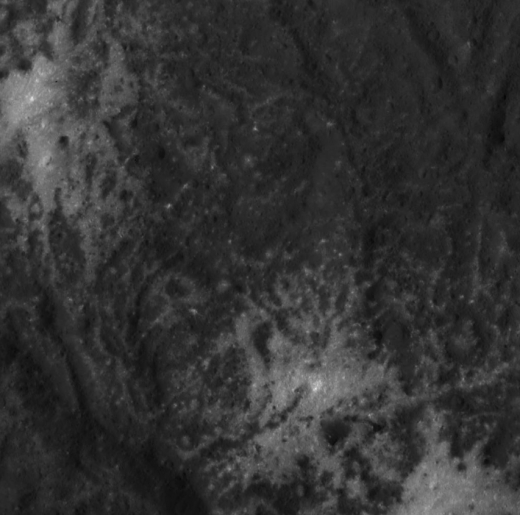
Image: This close-up image of the Vinalia Faculae in Occator Crater was obtained by NASA’s Dawn spacecraft on June 14, 2018 from an altitude of about 39 kilometers. This image reveals the intricate pattern between bright and dark material across this flow feature. The complex structure of the dark background is reminiscent of lava flows observed on Earth. However, in the case of Ceres, the flow material likely involved a lot of ice. The bright material is mostly composed of sodium carbonate, a salt whose exposure onto the crater floor involved a liquid source. The center of this picture is located at about 21.0 degrees north latitude and 241.3 degrees east longitude. Credit: NASA/JPL-Caltech/UCLA/MPS/DLR/IDA.

Uranus: Orbital Tilt from a Cataclysmic Collision
Yesterday’s post about exoplanet obliquity inevitably brought our own system to mind, with the stark variations between planets like Earth (23 degrees), Uranus (98 degrees) and Mercury (0.03 degrees) serving as stark examples of how wide the variation can be. Thus seasonality has to be seen in context, and interesting questions arise about the effect of high degrees of obliquity on habitability. While thinking about that I received a new paper on Uranus that has bearing on the matter, with its attempt to quantify the ‘hit’ Uranus must once have taken.
After all, something accounts for the fact that the 7th planet spins on its side, its axis at right angles to those of the other planets, its major moons all orbiting in the same plane. Lead author Jacob Kegerreis (Durham University), working with Luis Teodoro (BAERI/NASA Ames) and colleagues modeled 50 different impact simulations in an attempt to recreate the axial tilt of this world. In play were the planet’s internal structure, rotation rate, atmospheric retention post-impact and the composition of materials injected into orbit by the event. Says Kegerreis:
“Our findings confirm that the most likely outcome was that the young Uranus was involved in a cataclysmic collision with an object twice the mass of Earth, if not larger, knocking it on to its side and setting in process the events that helped create the planet we see today.”
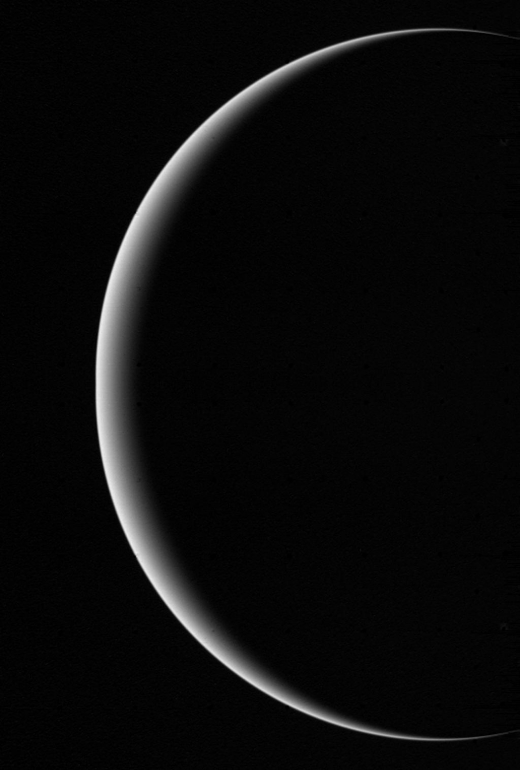
Image: This image shows a crescent Uranus, a view that Earthlings never witnessed until Voyager 2 flew near and then beyond Uranus on January 24, 1986. This planet’s natural blue-green color is due to the absorption of redder wavelengths in the atmosphere by traces of methane gas. Uranus’ diameter is roughly 51,000 kilometers, a little over four times that of Earth. Image credit: NASA/JPL/USGS.
The likely impactor was a young protoplanet, striking Uranus during the early era of Solar System formation some 4 billion years ago. That in itself is not surprising, though it’s good that the idea can be firmed up with high-resolution modeling. But we also learn something else. Debris from the impactor may have formed a thin shell near the top of Uranus’ ice layer. This could have the effect of trapping the heat emanating from the planet’s core, a useful finding because it helps to explain the extreme cold of the upper atmosphere (-216 degrees C).
Those temperatures are a puzzle that is exacerbated by the fact that we know so little about the interior of Uranus. The paper points out that surface emission is in equilibrium with solar insolation, which implies that little heat flows out from the planet, and this is in striking contrast with the other giant planets. Thus the idea of a thin thermal boundary layer between the outer envelope of hydrogen and helium and the inner ice-rich layer. The shell theory fits earlier work on the planet’s evolution, and also gives us some ideas about the type of impact.
Looking at where the mass and energy of the impactor are deposited within the planet, the paper focuses on the top of the ice layer, and suggests the impact was a grazing one:
Higher impact parameters can even lead to a temperature inversion near the top of the ice layer. These more-grazing collisions also leave the impactor ice further out, in a thin shell near the edge of the icy mantle, whereas ?head-on impacts can implant significant ice up to 0.5 R? further inwards and less-isotropically about the centre. These findings may have important implications for understanding the current heat flow (or rather lack thereof) from Uranus’ interior to its surface.
Thus we have a thermal boundary that can, as the paper argues, suppress convection, a kind of blanket to contain heat welling up from within the planet. We can also dig deeper into the planet’s magnetic field. Unlike the terrestrial planets, the Uranian magnetic field appears offset by approximately 0.3 Uranus radii from the center of the planet and tilted by 60 degrees relative to the rotation axis. Other work in the literature has described models that produce such fields using a layer of convecting electrically conducting ices. The impactor modeled in this work could have created lopsided clumps of rock within the planet that explain the offset and tilt.
An impactor of 2 Earth masses blows rock and ice into orbit, where it is available for the formation of Uranus’ current satellites and ring system, giving us constraints on the angular momentum delivered by the collision. All of which is a reminder of how violent a place a young stellar system can be during the era of planet formation, information which should prove useful as we extend what we are learning about our own ice giants to worlds around other stars.
The paper is Kegerreis, “Consequences of Giant Impacts on Early Uranus for Rotation, Internal Structure, Debris, and Atmospheric Erosion,” Astrophysical Journal Vol. 861, No. 1 (2 July 2018). Abstract / preprint.



